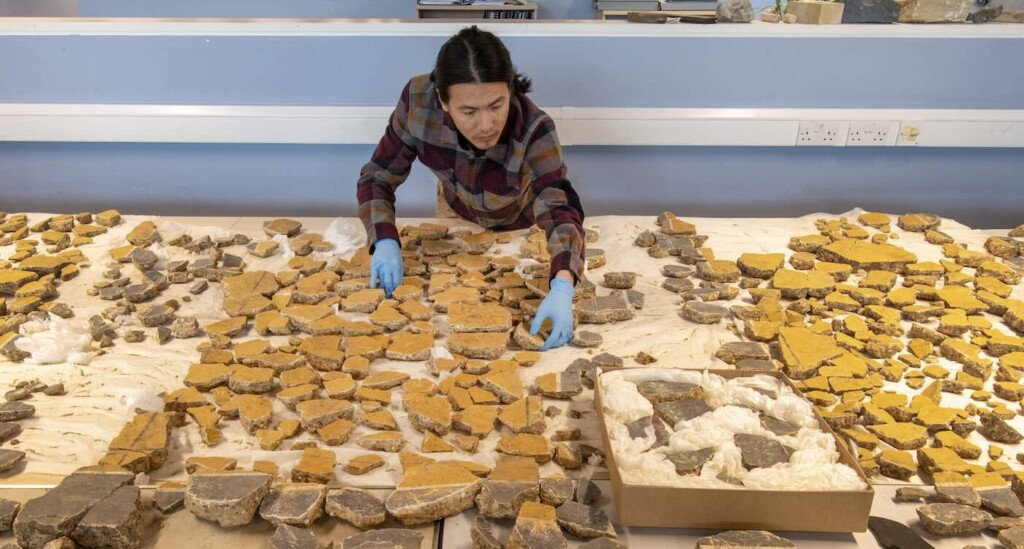
Excavations at a London development site have yielded one of the largest collections of painted Roman wall plaster ever discovered in the capital.
The painted wall plaster once decorated a high-status Roman building in Southwark, which was demolished some time before 200 CE.
Among the fragments is rare evidence of a painter’s signature, as well as unusual graffiti in the ancient Greek alphabet.
The discovery was made at a London development site which had already yielded stunning mosaics and a rare Roman mausoleum. Taken together, they suggest that the site was clearly one of paramount importance to the Roman presence in Britain.
Excavations were led by MOLA (Museum of London Archaeology).
The enormity of plaster hoard was, however, not immediately apparent. The decorated plaster was found dumped in a large pit, shattered in thousands of fragments—the result not of modern development, but of Roman demolition works which took place at some point before 200 CE.
It took three months for MOLA Senior Building Material Specialist Han Li to lay out all the fragments and painstakingly piece the designs back together. Now, for the first time in over 1,800 years, these vibrant artworks can be reconstructed to reveal their full glory.
“This has been a once in a lifetime moment, so I felt a mix of excitement and nervousness when I started to lay the plaster out,” said Han Li. “Many of the fragments were very delicate and pieces from different walls had been jumbled together when the building was demolished, so it was like assembling the world’s most difficult jigsaw puzzle.”
These paintings were designed to show off both the wealth and excellent taste of the building’s owner or owners. They include bright yellow panel designs with black intervals beautifully decorated with images of birds, fruit, flowers, and lyres (stringed instruments similar to harps).
While panel designs were common during the Roman period, yellow panels weren’t. They have been identified at only a few sites across the country, which include Fishbourne Roman Palace, one of Britain’s most luxurious Roman residences. Finding repeating yellow panels like these is even rarer.
The group or groups of painters responsible also took inspiration from wall decorations in other parts of the Roman world, such as Xanten and Cologne in Germany, and Lyon in France. Some fragments imitate high status wall tiles, such as red Egyptian porphyry (a crystal speckled volcanic stone) framing the elaborate veins of African giallo antico (a yellow marble). Styles like these have been found previously in England in Colchester, but also Germany and Pompeii.
Excitingly, the remains of their signature were found among the plasters—the first known example in Britain. This is framed by a tabula ansata, a carving of a decorative tablet used to sign artwork in the Roman world. It contains the Latin word ‘FECIT’ which translates to “has made this”. Tragically, the fragment is broken where the painter’s name would have appeared, meaning their identity will likely never be known.
MORE ROMAN RUINS: Archaeologists Stumble Onto Sprawling Ancient Roman Villa During Construction of a Road in France
The plaster also reveals traces left behind by the building’s owners and visitors in the form of ancient graffiti. This includes an etching of a near complete Greek alphabet, the only known example of this inscription from Roman Britain. Other examples in Italy suggests that the alphabet served a practical use, such as a checklist, tally or reference.
The skillfully scored letters suggest that it was done by a proficient writer and not someone undertaking writing practice.
YOU MAY ALSO LIKE: Tiny House with Elaborate Frescoes of Mythical Scenes Unearthed From the Ashes at Pompeii
Work to further explore each piece of plaster continues. Han Li, with the help from his MOLA colleagues, will continue to analyze the work by this group or groups of painters, comparing the Liberty wall paintings to others from Britain and the wider Roman world. The results will be published and fragments archived for future study, as well as made available for temporary or permanent display.
“I was lucky to have been helped by my colleagues in other specialist teams for helping me arrange this titanic puzzle as well as interpret ornaments and inscriptions—including Ian Betts and the British School at Rome—who gave me their invaluable opinions and resources,” said Han Li in a statement from MOLA. “The result was seeing wall paintings that even individuals of the late Roman period in London would not have seen.”
SHARE This Wildly Antique Discovery Right From The Heart Of London…







